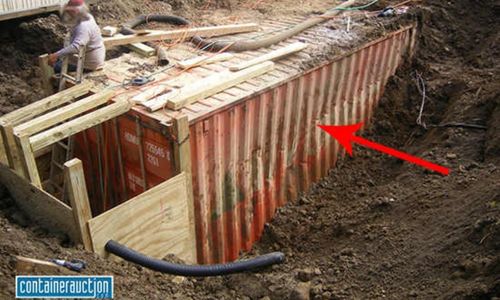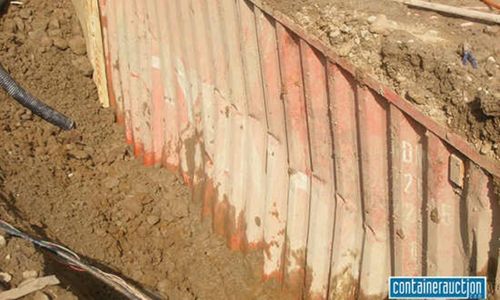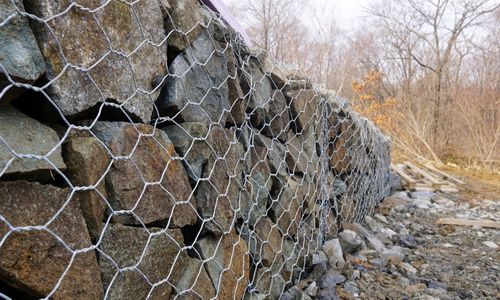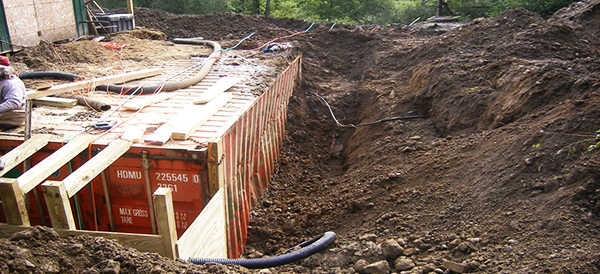It’s one of those trends that has gained more and more popularity in recent years: burying a shipping container to create a shelter. I did my research, and I had to say it sounded like it was too good to be true.
Why? Because a shipping container costs around $2,500, and that is a pretty good price to make yourself a bunker or a root cellar.
At one point I was almost determined to do it myself. Luckily for me, I didn’t have $2,500 laying around at that moment.
Can You Bury A Shipping Container?
I’m a curious guy, and I really wanted to know if it was worth saving money for it.
Was it just a useless, and possibly dangerous, trend, or was it something I should actually invest my time and money in?
Related: How to Keep Your Money Safe for When SHTF
After extensive research, I still didn’t have the money, but I had an answer to this question. Keep reading to see if it’s a viable option for you and if it’s worth the hassle.
The Pros
If you’re willing to dig and bury it yourself, you can end up with a root cellar or a storm shelter for a somewhat decent amount of money.
But that is if you do it yourself—starting from the excavation itself to the actual burying of the container, with no contractors or heavy machinery you have to pay for. If you don’t have the right tools—and let’s face it, most of us don’t—you should prepare for an additional cost of at least $6,000.
But I did find an option that is significantly cheaper and that doesn’t involve contractors and extra costs. You can check it out here.
Another thing to consider is the fact that you don’t need a special permit to do this. Just make sure you do it on your property and, if possible, away from any neighbors’ curious eyes.
And if you have the right tools, I’d say it’s quite an easy job. Depending on how much time you have on your hands, I would venture to estimate it’s probably four days of work. For what you get in the end, it could prove to be a good use of your time.
The Cons
Where should I begin?
As you’ve seen, there are a few benefits to moving along with such a project, but the problem with it is it’s not the safest thing you can do.
In fact, it can be very dangerous and potentially life threatening. So if you decide to do it, you should prepare for some serious consequences.
Shipping containers are giant, portable metal boxes that can hold a lot and were specifically built to be stacked on top of each other.
That’s also why people think they could make a great bunker. If you want to know what works as a bunker, I suggest you take a look at this.
What Really Happens When You Bury A Shipping Container?
Shipping containers are designed to hold a lot of weight, that part is true, but only on the corners, not on the sides.
They were not, by any means, designed to become survival bunkers. If you try to bury it, you will put a lot of extra pressure on the sides and ceiling.

As you can see, the weight of the soil caused the walls of the container to buckle in. The corners seem to be straight, but it’s hard to say if that’s the case on the inside.
Another factor to consider is water. If the container is buried in an area with a high-water table, it may seep into your container and cause even more damage to the structure and its contents.
So what really happens if you bury a shipping container is, you’d put a lot of hard work and money into something that could turn into a real disaster in a survival situation.
Look at the pictures again, and imagine you and your loved ones were inside. Do you really think a thin piece of metal will hold up to the pressure? You can probably see by now that will be impossible. Your shipping container will become a death can.
What To Do If You Really Want To Go On With This
So let’s say that after everything you’ve just read, you still want to go on with this project. The only way you can make it is to reinforce it with something called a gabion basket.
That’s basically a cage made of steel. They are usually filled with stones, and they’re used to support a hill alongside a major highway.
After you dig the hole, you fill it with a stone foundation and then surround your container with the gabion baskets. This lessens the chance of having your shipping container cave in from the weight of the dirt.
But I couldn’t find any proof that this works other than in theory. Another thing that could work is reinforcing the sides by pouring concrete on all four sides and adding metal bars. But at this point, you might as well skip the container completely.
And while you may lessen the pressure from the soil, it will do just the opposite to your bank account.
In conclusion, it can be done. But just because something can be done doesn’t mean it should be done. And when you debate something as important as keeping you and your family safe in a disaster situation, I prefer to choose the option with more pros than cons. Luckily, there are better, cheaper, and safer ways to build something to protect your life and your stockpiles in the next crisis.
You may also like:
 12 Potentially Life-Threatening Errors You’re Making in Food Preparedness and Survival Strategies
12 Potentially Life-Threatening Errors You’re Making in Food Preparedness and Survival Strategies
An Insanely Effective Way to Build a 5 Year Food Stockpile (Video)
What’s The Closest Natural Nuclear Bunker to Your Home?
72 Types Of Americans That Are Considered “Potential Terrorists” In Official Government Documents















A better idea!? Purchase an 8ft. diameter piece of culvert about 12ft. long. Have your local junior college vo-tech welding school weld an 8X8 1/8″ piece of metal on either end with a cutout for a door on one end.weld angle iron on the inside along the length such that you can lay planks across the width and have about a 6 1/2′ foot center height and about 1 1/2′ of storage beneath. Have a hole cut in the center top for a turbine vent. Paint with a zinc based paint, bury and enjoy. My local vo-tech college only charges for materials but expects a donation for labor…total cost…about $600!
Great idea! Thanks!
That’s awesome.
How much would the culvert itself cost though? I’d love to find a decent source to buy culverts that size (or larger) at an affordable price…
If you’re really wanting to use a shipping container for a SHTF shelter, do what you said with the HS/Junior College do the welding. But what you do is either weld box tubing to the steel hull on the inside or outside. Another thing you could do is encase the whole thing in concrete with regard. If you opt to weld the exterior hull instead of spraying it with zinc oxide (which a good idea), spray on truck bed coating/Herculiner stuff. But it needs to be sprayed on all 4 sides
That’s one of the things the article discussed, “encase the whole thing with concrete.” It’s too expensive!
Septic tank works great
To me that looks like during driving around that container rubbed up against something. That would create a weakness that could result in cave-in especially as it rusts more.
That is a crease/kink in the side wall where the metal bent due to the pressure of the dirt…
My impression as well.
Well if any of you have actually worked with shipping containers you would notice and know that that crease is most likely the reason the container was sold off in the first place. And that excessive (Forced) earth/dirt side pressure on these containers would only cause a “Bow” NOT a “Crease”. Natural “back-filling” would not and can not cause a shipping container to collapse or even bow!
Also the basic 20″ HC shipping container has 5x the structural strength as a standard 1800sf (US code) stick built house.
I do see many things wrong in these two pictures and “all” are in the design and procedure issues, not structural. I have seen these pictures before… Regurgitated by clueless “Prepper want-a-be writers”. And yes, the individual who’s container this is didn’t account for drainage clearly seen in the 2nd pic. Again, a owner design failure and has nothing to do with the container!
So these “re-posted” pic’s of discouragement are nothing but filler for editors desperate for article content and have no real basis in reality…. And are in fact, just BS claims by someone who knows nothing about shipping container usage.
And on a side note: Large diameter culvert piping works good as well. However the same container prepping is required to “DO IT RIGHT”. And if you are planning on putting in any kind of floor, an 8 foot will only have approx. 5 feet of height after any usable flooring is installed.
*** And a note to the editor: “No one likes false and misleading trash articles!” Please at lease take the time to educate yourselves! You are doing an injustice to many of your followers who clearly are believing your lies and depriving them of this successfully time tested security option!
Thank for the update Dan the van man and taking the fear away of building cheaply nice shelters.
Dan, why are you such a hater?
If things can go wrong, they will. Here is how you should bury a shipping container: http://containerauction.com/read-news/how-to-bury-a-shipping-container-gabion-basket
Ashley, Not being a hater. But what I am is… Educated and educated on the proper use of shipping containers! Yes, things can go wrong. Not denying that, but they don’t have to! If you plan “correctly” the likelihood is very low and there will always be unforeseen challenges.
My point is that “some” folks… ie: the author of this post clearly had/has no working knowledge or experience whats so ever of proper placement procedures when it comes to burying a shipping container. And that “The proper Procedure” varies depending on location climate and terrain.
And as for Gabion baskets go there are terrains where they are the best idea ever and in others using them will cause your failure.. You simple NEED to educate yourselves prior to starting your project. In the original post above you see a failed project yes.Failed miserably! But the container was not the reason! The owner was the reason, nothing more. Poor planning and procedure! The damage on the side was not caused by “earth” being pushing in and collapsing the container. Earth packs downward, not sideways. It’s a “Gravity” thing.. My argument was that the author faulting stated “As you can see from the pictures below, the weight of the ground caused the curb side walls of the container to buckle” which is a battened lie! And if “I hate.” I only hate “False information.” and “ignorance”. So when I see these pictures pop up every few years (These exact same pic’s) and someone new try to discourage folks from using shipping containers. Yes, it does irritate me when I see ignorant people spreading bad info….
DantheVanMan,
Maybe the last 6 years have taught you not to be quite such a tool anymore. Please stop telling other people they’re ignorant, when you don’t understand gravity. Dirt packs downwards? Really? So all those construction sites that shore up backfilled dirt are just, what, making pretty 4 inch thick reinforced concrete walls? Let me guess, you just stack dirt up as high as you want and build anything on top of it without it moving to the side at all? The average home basement has thick cast concrete walls because there’s just a surplus of cement and we can find no other use for it?
So yes, the lateral force of dirt is actually a thing, as anyone in construction will tell you. And the amount of force it exerts exceeds the what a shipping container can hold without additional reinforcement. Shipping containers obviously aren’t designed to withstand lateral force, but vertical down force at the corners. You CLEARLY do not have the first clue what you’re talking about.
You clearly didn’t get this article.
1. Before posting a comment about an article, at least read it first. This is by no means a “discouragement” article, but a “some things you should take into consideration before burying a shipping container” or “cautionary tale” if you want.
You could’ve at least read the beginning of the article: “…you can end up with a root cellar, a storm shelter, a small bunker and a last-resort hideout …for a decent amount of money. And although it is possible and there are a lot of preppers who’ve already done that, there are some things you should be wary of.”
2. This article is written by a man who earns a living selling shipping containers to preppers. He has no interest in making up a story like that. The men who buried the shipping container was one of his customers and the shipping container (according to Ryan) was not damaged or bend before.
If someone wants to bury a shipping container, he/she might want to read this first… just to know a few things that can (but not necessarily) go wrong, including water infiltration.
Thank You DanTheVanMan for clearing that BS up. I have a container in the ground. Been there for 5 years with no problems. Of course, I didn’t just stick it in the ground and cover it up. It took planning to do it right.
My plan is to use old tires for the sides. Fill them with dirt and backfill on the outside of the tires. Since dirt weighs 125-145 pounds for every cubic foot of dirt, I believe I will put 4-6 inches of dirt over the top of the container. All after I coat the outsides of the containers with rino coating, or something equally long lasting. I am looking to live in these 2-40 footers as a tiny house
The cost of Gabion basket, buying enough rock to fill the baskets, and don’t forget the trucking cost for the rock. I have built and filled Gabion baskets before and other than the total cost to buy and fill them is a huge pain! Tires can be got for free to $5 each and if you are going to bury the containers, the. You’ll have plenty of dirt to fill the tires
These things are stacked at least 5 high on ships. How could a little dirt collapse this wall? Agree that it was probably damaged and sold cheap.
Because only the corners carry load when stacked on ships, even 10 high. The walls and roof are relatively thin sheet metal carrying almost no load at all.
I am a structural engineer and never thought burying one of these was a good idea in general. Structurally they are not made to be used this way. Even if the dirt doesn’t collapse it then it might collapse later due to ground water up against it and changing the physical properties of the earth to put even more pressure against it. The type of soil that is used for backfilling is very important.
We are wanting to bury a container for a storm shelter and cellar. The ground where we live is gray slate; very hard. There is only about 6 inches of top soil here. What we want to do is dig a “trench” and put the container in it and cover it with only a little dirt. There would not be a water problem because the front will be left open and graded slightly downhill for a water drain since we live on a hill and there is a slightly higher hill behind us to put a trench. Good idea?
Corrosion engineers deal with buried pipelines and galvanic electronic charges using sacrificial ingots that corrode instead of pipelines.
What is done for buried shipping containers?
I have buried a shipping container, the weight of the fill on the roof did cause it to start to cave in. We installed 2 beams the length of the container and supported them every 8 feet with a post. we used the post to build shelves. the container was buried where there is gravel instead of dirt so there is no drainage problem. We also a 4″ piece of PVC pipe in the roof that extends to the floor and placed a solar powered dog house fan on the outer end for ventilation. the container is accessed threw a doorway we cut in the basement foundation, it’s a hidden door that you wouldn’t now is there.
We also coated the container in heave tar before it was buried